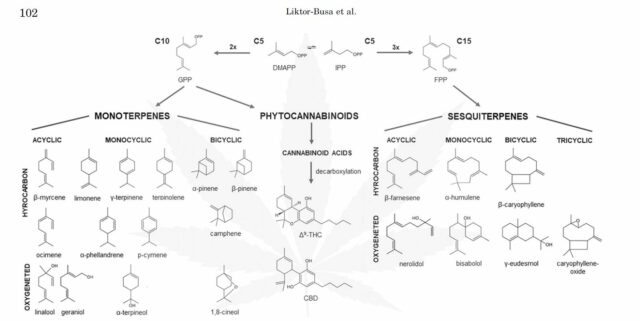As legalization and availability of marijuana increase, more scientists are turning to terpenes as being potential key players in the pain-killing properties of the plant.
A recent review by researchers at the University of Arizona summarizing the latest terpene studies concluded that, while there’s still a lot more research required, the scent-producing molecules are attractive compounds for the development of analgesics — especially given their safety profile of low toxicity and relatively few side effects.
The paper, published in the journal Pharmacological Reviews, focused on the most common terpenes found in cannabis.
Check out our recently published review on Cannabis terpenes for pain relief! Led by the talented but sadly Twitter-less Dr. Tally Largent-Milnes, with an assist from @Viva_LaVig. https://t.co/LJ1B65V00w
— John Streicher (@JohnStreicher1) October 18, 2021
According to the authors, increased availability and legalization has led to more people treating pain with cannabis, making it a potential aid in addressing the opioid crisis.
“Better understanding of the pharmacological effects of cannabis and its active components, including terpenes, may assist in identifying new therapeutic approaches and optimizing the use of cannabis and/or terpenes as analgesic agents,” reads the study.
“The terpene biochemical diversity present in cannabis and their co-expression with phytocannabinoids is unique and remarkable.”
Read more: Terpenes imitate and enhance cannabinoid activity: study
Read more: Why including terpene content on weed packaging is common scents

Terpenes may produce their pain-killing and anti-inflammatory properties by targeting specific receptors in cellular membranes. Image via ‘Potential of Terpenes Derived from Cannabis sativa’
Terpenes found in cannabis work on key receptors
There’s more to terpenes than meets the nose, as evidence shows they likely play a strong role in cannabis’s complex pharmacological profile.
In previous research, terpenes found in cannabis may express their pain-killing and anti-inflammatory properties by targeting the THC-specific cannabinoid receptor CB1, as well as the inflammation-related receptor adenosine A2a.
For the review, scientists focused on relatively common terpenes including geraniol, pinene, linalool, β-Myrcene, humulene and limonene.
Researchers found limonene was linked to strong anxiolytic and anti-inflammatory effects, but evidence of its pain-killing effects is limited. Geraniol has a sweet smell, and is associated with analgesic, anticancer and anti-inflammatory properties.

Terpenes are classified as monoterpenes and sesquiterpenes depending on their molecular composition. Image via ‘Potential of Terpenes Derived from Cannabis sativa’
Linalool, found in cannabis and also in lavender, has significant anxiolytic and sedative effects, according to some studies, while β-Myrcene and limonene have shown to be highly sedative.
Humulene is one of the most abundant terpenes in cannabis, as well as in hop plants, but there are no studies that have looked into its pain-killing properties.
The review recommends that future studies focus on basic research, as well as pre-clinical and clinical trials to determine short and long-term medical benefits of terpenes.
“Moreover, these future studies will need to consider appropriate placebos that account for odour and include the psychologic component of terpene-mediated outcomes,” reads the study.
Read more: Smell to feel well with The Cannabis Sommelier’s new book
Classifying cannabis by correlating scent profiles with sativa and indica categories
Another recent article, published in the journal Nature Plants, suggests a genetic classification system for cannabis correlating terpene profiles with the popular sativa and indica categories.
“Our results suggest that a practical and reliable classification system for cannabis that is consistent with contemporary understanding of the terms ‘sativa’ and ‘indica’ may be achievable by quantifying a small number of terpenes and/or genotyping genetic markers associated with key cannabis aromas,” reads the study led by researchers at Dalhousie University.
Sativa was correlated with concentrations of bergamotene and farnesene, which produce tea-like and fruity aromas, respectively. Indica had a strong correlation with the sedative and earthy-smelling myrcene.
“In addition, there is evidence to suggest that a cultivar’s terpene profile affects its psychoactive properties,” reads the study by Nature.
Follow Natalia Buendia Calvillo on Twitter
natalia@mugglehead.com














